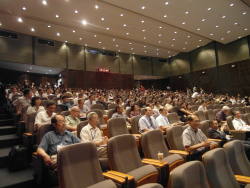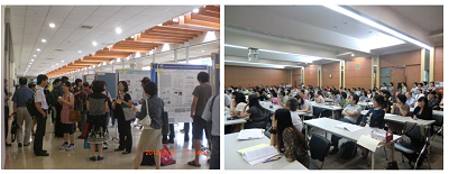NHRI Communications

會議報導
101年度國家衛生研究院生物醫學學術研討會紀實
Report on 2012 Biomedical Research Symposium of National Health Research Institutes
 本院致力於推動院外整合性醫藥衛生科技研究計畫(以下簡稱整合性計畫)已10餘年,且定期舉辦整合性計畫研究成果發表會。自2008年起,為了讓整合性計畫卓越成果得以分享,期望有效地促進整合性計畫研究人員、本院研究人員,以及各界相關領域研究人員之交流與互動,將每年一度的整合性計畫研究成果發表會改以主題式研討會擴大舉辦為「國家衛生研究院生物醫學學術研討會(Biomedical Research Symposium of National Health Research Institutes)」。會議於每年8月暑假期間辦理,以涵蓋各領域的國際學術研討會方式與國內外學者進行交流,除了展現本院歷年支持的院內外研究成果,更冀望成為國內外生醫學界朋友在暑期積極參與的學術盛事。
本院致力於推動院外整合性醫藥衛生科技研究計畫(以下簡稱整合性計畫)已10餘年,且定期舉辦整合性計畫研究成果發表會。自2008年起,為了讓整合性計畫卓越成果得以分享,期望有效地促進整合性計畫研究人員、本院研究人員,以及各界相關領域研究人員之交流與互動,將每年一度的整合性計畫研究成果發表會改以主題式研討會擴大舉辦為「國家衛生研究院生物醫學學術研討會(Biomedical Research Symposium of National Health Research Institutes)」。會議於每年8月暑假期間辦理,以涵蓋各領域的國際學術研討會方式與國內外學者進行交流,除了展現本院歷年支持的院內外研究成果,更冀望成為國內外生醫學界朋友在暑期積極參與的學術盛事。 101年度國家衛生研究院生物醫學學術研討會(2012 Biomedical Research Symposium of NHRI)已於8月13日至14日假本院會議中心召開。此次會議除有整合性計畫研究人員參與外,亦邀請院外計畫學術審查之國內外專家60餘位共同與會,另開放本院研究人員及國內各機構研究人員報名與會,總計人數約520餘人次,可謂盛況空前,充分達到學術交流之目的。此次會議首日上午由本院伍前院長焜玉主持開幕,隨後邀請美國羅徹斯特梅約醫學中心安介南教授以「Clinical Applications of the Tribology of Tendon Gliding註1」為題發表演說;次日上午則邀請美國耶魯大學藥理系鄭永齊院士以「Why and How to Explore Traditional Chinese Medicine for Developing Future Medicine註2」為題發表演說。
101年度國家衛生研究院生物醫學學術研討會(2012 Biomedical Research Symposium of NHRI)已於8月13日至14日假本院會議中心召開。此次會議除有整合性計畫研究人員參與外,亦邀請院外計畫學術審查之國內外專家60餘位共同與會,另開放本院研究人員及國內各機構研究人員報名與會,總計人數約520餘人次,可謂盛況空前,充分達到學術交流之目的。此次會議首日上午由本院伍前院長焜玉主持開幕,隨後邀請美國羅徹斯特梅約醫學中心安介南教授以「Clinical Applications of the Tribology of Tendon Gliding註1」為題發表演說;次日上午則邀請美國耶魯大學藥理系鄭永齊院士以「Why and How to Explore Traditional Chinese Medicine for Developing Future Medicine註2」為題發表演說。除前述特別演講外,另規劃「Molecular Genetics and Medicine」、「Neural Science」、「Cancer Research」、「Medical Engineering」、「Biomedical Science」及「Population Health Research」等6項專題演講,由執行成果優良之整合性醫藥衛生科技研究計畫主持人、本院研究人員或年輕研究學者及國內外專家共26位,於2個會場同步進行演講,分享其研究成果與經驗,促進學術交流及研究合作。
 囿於演講場次有限,本次會議另安排2個壁報時段(poster session),由整合性計畫主持人及本院研究人員張貼壁報展示研究成果(共計發表147篇壁報論文),並於第二天下午分組安排壁報論文討論會議(poster discussion),由各組會議主持人邀請部分壁報展示之研究人員簡短報告分享研究成果,以促進壁報發表者、計畫主持人、所有分組與會人員及學術審查委員間之討論與互動,除有助於委員瞭解計畫執行成效,亦能協助解決研究過程可能遭遇之困難。
囿於演講場次有限,本次會議另安排2個壁報時段(poster session),由整合性計畫主持人及本院研究人員張貼壁報展示研究成果(共計發表147篇壁報論文),並於第二天下午分組安排壁報論文討論會議(poster discussion),由各組會議主持人邀請部分壁報展示之研究人員簡短報告分享研究成果,以促進壁報發表者、計畫主持人、所有分組與會人員及學術審查委員間之討論與互動,除有助於委員瞭解計畫執行成效,亦能協助解決研究過程可能遭遇之困難。在兩天的學術活動中,藉由演講、壁報論文展示及分組討論會議等安排,引發熱烈討論及腦力激盪,使與會人員獲益良多,且因交流互動增加,而致未來合作或團隊研究形成之可能,為國人之醫藥研究發展水準厚植潛力。
註1:安介南教授特別演講摘要(演講內容請見電子報第468期「影音節目」)
Clinical Applications of the Tribology of Tendon Gliding
In the past half-century, biomedical engineering has provided great contributions to biomedical science, and more importantly, has translated many findings from bench to bedside. Further, biomedical engineering research is usually carried out by involving many disciplines. In this lecture we will review the study of tendon gliding to improve the treatments of two clinical problems; tendon repair and carpal tunnel syndrome (CTS).
Tendon is an anatomic structure that transmits forces from muscle to bone to enable joint movement and provide function in the extremities. The long tendons in the hand experience great excursion during the movement of the digits. Friction of the tendon against the surrounding bony and pulley structures is to be expected. Thus, proper lubrication is important. One of the clinical challenges in repair of lacerated tendons is adhesion formation after surgical repair of the traumatically-lacerated tendon, which usually requires additional surgical procedures. Therefore, to accomplish adhesion-free tendon repair is one of the goals of our research. Carpal tunnel syndrome is a prevalent neurological problem of the hand. The ultimate treatment is surgical release of the transverse ligament which is relatively successful. However, our research goal is to better understand the etiology of carpal tunnel syndrome so that the syndrome can be prevented or surgical treatment is not necessary.
Our research on the tribology of tendon gliding has grown out of two simple principles. The first mathematical principle describes the relationship between the tendon excursion and the joint rotation through the size of the moment arm. The second physical principle relates the friction between the tendon and pulley to the frictional coefficient and angle of wrap in an exponential form. For intra-synovial tendon, the low friction of gliding is accomplished through boundary lubrication with three excellent lubricants: hyaluronic acid, phospholipid, and lubricin. On the other hand, for the extra-synovial tendon such as those in the carpal tunnel region, the tendons are surrounded by the subsynovial connective tissue (SSCT). The gliding mechanism is accomplished through sliding of multiple membrane layers. Micro damage of the SSCT due to repetitive tendon movement could initiate fibrosis and eventually lead to nerve compression, which is our hypothesis for the etiology of CTS. Two animal models have been developed to support this hypothesis.
Post surgical rehabilitation based on the tendon-joint excursion relationship combined with the coating of novel lubricants provide opportunity for adhesion-free tendon repair. For the treatment of CTS, anti-fibrosis treatments are under exploration to prevent and reverse the process. In addition, ultrasonic-based medical imaging technologies, including shearwave dispersion ultrasound vibrometry, are used to assess the characteristics and properties of the SSCT for more sensitive early diagnosis and biomarkers for different treatment considerations.
We are humbled that through our multi-disciplinary collaborative research based on two simple concepts, two common tendon-related disorders can be better managed.
註2:鄭永齊院士特別演講摘要
Why and How to Explore Traditional Chinese Medicine for Developing Future Medicine
The paradigm of health needs in the world has shifted from disease care to health care. Thus, the scope of the medicine needed today is not just therapeutic medicine but also preventative medicine, functional medicine, as well as accessory medicine. Given the complex etiology of cancer, cardiovascular disease, bone and marrow functional degeneration, neuronal degeneration, immune dysfunction and metabolic diseases, the current reductionist approach of mainstream pharmaceutical discovery will not be sufficient. Polychemical medicine with the system biology approach will be needed. TCM often had medical claims for the treatment of complicated diseases or multiple symptoms as well as disease prevention and improve the quality of life. Those multiple claims for giving Chinese medicine may be due to the complexity of chemicals which could target on multiple sites. The evolvement of TCM took a holistic approach is an early form of “system biology” based “integrative medicine” which is currently pursued by mainstream medicine. Thus, if those claims are proven, it will help to meet current unmet clinical needs. It could also serve in complementation with mainstream medicine as a cornerstone to develop future medicine. In order to be accepted globally, it has to fulfill the requirements for developing modern medicine:
1. Preparation needs to be consistent. This is a major issue for TCM to be accepted globally.
2. Evidence for clinical efficacy and their safety of TCM are needed to be established using globally accepted criteria.
3. Certain knowledge of its action such as the sites of action, active ingredients and the interaction with currently used mainstream medicine.
《文/圖:學術發展處蕭振祥》